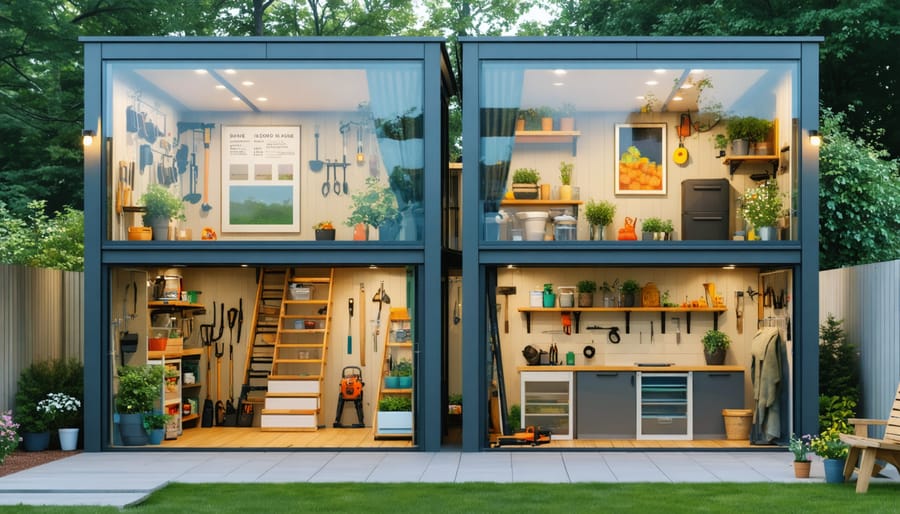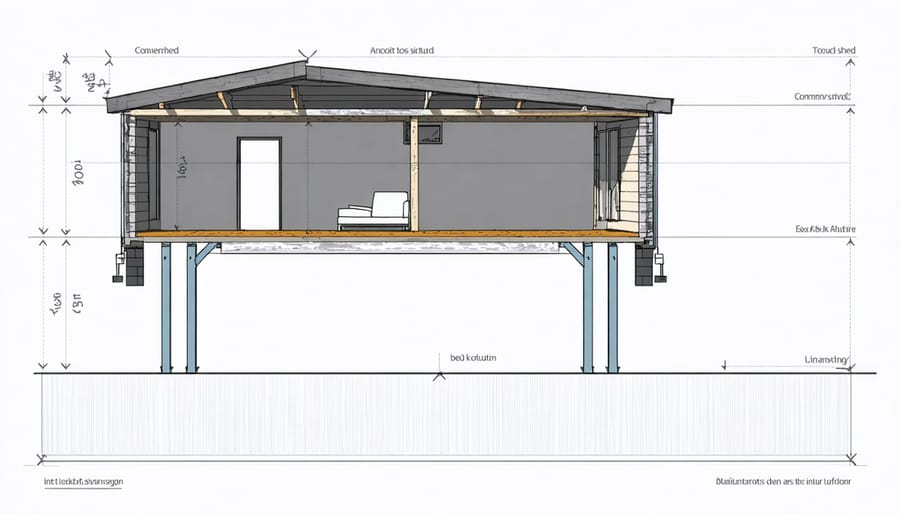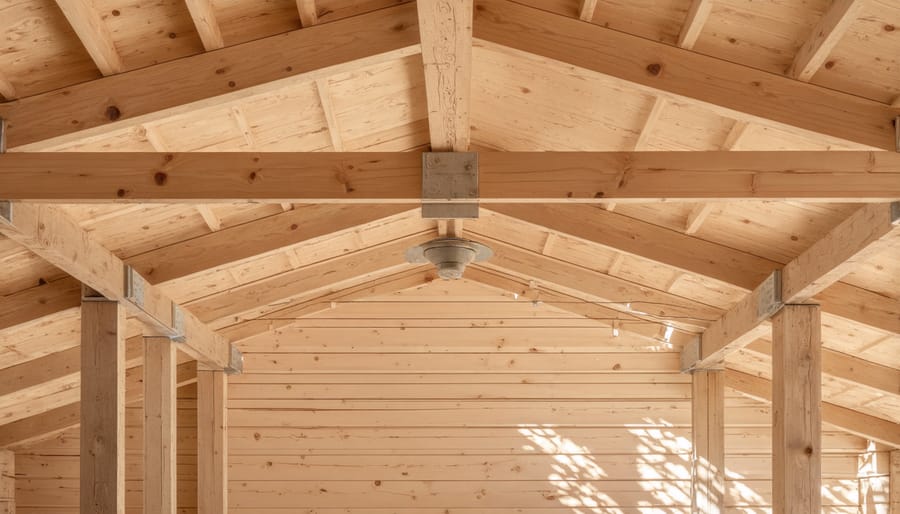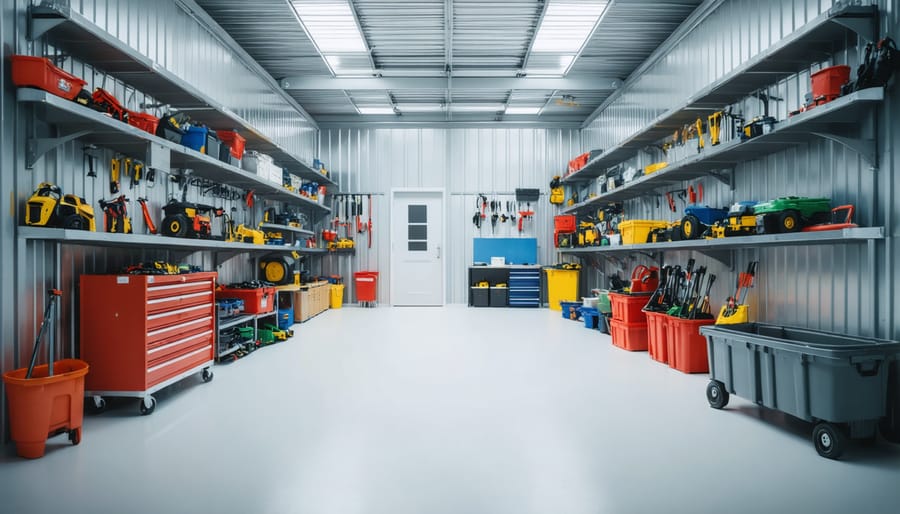Double Your Shed Storage Space: Smart Two-Level Organization That Works

Transform your cramped storage space into a multi-functional powerhouse with a two-level shed system that doubles your available square footage. Installing raised platforms, sturdy staircases, and proper load-bearing supports creates an efficient storage solution that maximizes vertical space while keeping tools and equipment easily accessible. Learn how to organize your shed effectively by designating specific zones – store frequently used items on the ground level and seasonal equipment above. A well-designed two-level shed not only enhances property value but also brings professional-grade organization to your backyard storage, combining the convenience of a traditional shed with the spatial efficiency of a small warehouse.
This innovative approach to storage management transforms the traditional garden shed into a dynamic space that works smarter, not harder. With proper planning and strategic organization, a two-level shed system becomes more than just storage – it’s a practical solution that brings order to chaos while maintaining easy access to all your outdoor essentials.
Planning Your Two-Level Shed Layout
Space Assessment and Measurements
Before diving into construction, it’s crucial to carefully assess your available space and plan your two-level shed’s dimensions. Start by measuring the total footprint area where your shed will stand, including any required setbacks from property lines. Remember to account for door swing space and access paths around the structure.
For optimal functionality, measure the height of items you plan to store on each level. A good rule of thumb is to allow at least 6 feet of headroom for the ground level if you’ll be walking inside. For the upper level, consider the height of your tallest storage items plus an additional 12 inches for easy access.
Take note of any overhead obstacles like tree branches or power lines that might affect your maximum height. Most residential areas allow storage sheds up to 15 feet tall, but always check local building codes before finalizing your plans.
When determining level heights, think about the items you’ll store and how often you’ll need to access them. Frequently used items should be on the ground level, while seasonal items can go upstairs. Consider installing a pull-down ladder or permanent stairs – this will influence your space planning. Leave at least 3 feet of clearance in front of access points for comfortable movement.
Make sure to measure any large items like lawn mowers or workbenches before finalizing your design to ensure they’ll fit through doorways and have adequate space for maneuvering.

Weight Distribution Considerations
Proper weight distribution is crucial for the safety and longevity of your two-level shed. The upper level typically should not bear more than 40% of your total storage weight, with heavier items always placed on the ground floor. When loading the upper level, distribute items evenly across the floor joists to prevent stress points that could lead to sagging or structural damage.
For optimal support, install vertical posts or support beams every 4-6 feet along the length of your upper level. These should run from floor to ceiling and be properly anchored at both ends. A good rule of thumb is to use 4×4 pressure-treated posts for standard storage loads, ensuring they’re perfectly plumb during installation.
The floor joists of your upper level should be sized according to the intended load – typically 2×8 or 2×10 lumber for spans up to 12 feet. Remember to factor in both dead loads (the weight of the structure itself) and live loads (stored items and people accessing the space) when planning your support system.
Consider creating designated zones on each level based on weight. Keep lawn equipment, heavy tools, and bulk materials on the ground floor, while reserving the upper level for lighter items like holiday decorations, empty containers, and seasonal clothing. This strategic organization not only ensures structural integrity but also makes accessing your items more practical and safe.
Building Your Upper Level
Materials and Support Structures
Building a sturdy two-level shed requires careful material selection and proper support installation. For the main structure, you’ll need pressure-treated lumber for the base frame, including 2×6 floor joists and 4×4 support posts. The walls should be constructed with 2×4 studs, while the second level requires additional 2×6 floor joists and ¾-inch plywood for enhanced load-bearing capacity.
Essential materials include:
– Pressure-treated lumber (various dimensions)
– Exterior-grade plywood sheets
– Galvanized screws and nails
– Heavy-duty brackets and joist hangers
– Concrete pier blocks or footings
– Weather-resistant siding
– Roofing materials and underlayment
– Hardware for stairs or ladder access
Support structures are crucial for a safe and durable two-level setup. Install concrete pier blocks at least 12 inches below the frost line for foundation stability. Space floor joists 16 inches on center and reinforce corners with diagonal bracing. For the second level, install additional support posts every 6-8 feet and ensure proper load distribution through doubled headers above openings.
Remember to incorporate proper ventilation for stored items during the construction phase. Use hurricane ties and metal strapping to secure roof-to-wall and wall-to-foundation connections, especially in areas prone to high winds. Consider adding a moisture barrier beneath the flooring and behind siding to protect your investment and stored belongings from weather damage.

Safety Features and Access Solutions
Safety should always be your top priority when using a two-level shed, and proper access solutions are essential for comfortable daily use. Start by installing sturdy railings along any elevated platforms or walkways, using weather-resistant materials like galvanized steel or treated lumber. These railings should be at least 36 inches high and capable of withstanding 200 pounds of force from any direction.
For accessing the upper level, consider your comfort and frequency of use when choosing between stairs or a ladder. Stairs are ideal if you’ll be moving larger items or accessing the upper level frequently. Install them at a comfortable angle (around 35 degrees) with non-slip treads and handrails on both sides. For space-saving alternatives, consider fold-down stairs or a heavy-duty pull-down ladder system.
If opting for a permanent ladder, ensure it’s securely anchored to both floor and upper level, with rungs spaced 10-12 inches apart. Installing grip tape or non-slip surfaces on ladder rungs provides extra security during wet weather. For additional safety, add motion-sensor lighting near access points to ensure clear visibility during early morning or evening use.
Remember to keep access ways clear of obstacles and regularly inspect all safety features for signs of wear or damage. Installing a small landing area at the top of your stairs or ladder gives you stable footing while managing items. For convenience, consider adding grab handles near entry points to assist with balance when carrying items up and down.

Smart Organization Strategies
Lower Level Organization
When organizing the lower level of your two-level shed, prioritize placing heavier and frequently accessed items for easy reach and safer handling. Start by implementing smart storage solutions like heavy-duty shelving units along the walls, leaving the central floor space clear for larger equipment and improved accessibility.
Position lawn mowers, wheelbarrows, and heavy power tools near the entrance for quick access. Install wall-mounted tool racks and pegboards at eye level to keep frequently used hand tools within easy reach. Consider adding rubber floor mats in high-traffic areas to prevent slipping and protect the floor from moisture and wear.
Create designated zones for different categories of items: gardening tools in one area, power equipment in another, and seasonal items in a third. Use weatherproof storage bins with clear labels for smaller items like seeds, fertilizers, and garden supplies. Install hooks on support posts for hanging long-handled tools vertically, maximizing floor space while keeping items organized.
For better weight distribution, place the heaviest items directly on the floor rather than on shelves. If storing chemicals or fuels, keep them in sealed containers in a well-ventilated area away from heat sources. Add motion-sensor lighting to ensure good visibility when accessing items, especially during early morning or evening hours.
Remember to maintain clear pathways between storage zones, allowing for easy movement and preventing the need to move multiple items to reach what you need. This thoughtful organization of your lower level creates an efficient workspace while ensuring the safety and longevity of your stored items.
Upper Level Storage Solutions
The upper level of your two-level shed offers perfect storage potential for lighter, seasonal items that don’t require frequent access. Make the most of this space by using clear plastic bins with secure lids to protect your belongings from dust and moisture. Label each container clearly, and consider creating a simple inventory system to track what’s stored where.
Holiday decorations, camping gear, and out-of-season clothing are ideal candidates for upper-level storage. Install adjustable shelving units along the walls to maximize vertical space and create flexible storage options. Consider using vacuum storage bags for soft items like sleeping bags and winter coats to reduce bulk and protect them from moisture.
To ensure safe access to your upper-level items, invest in a sturdy folding ladder or rolling ladder system that can be easily stored when not in use. Install proper lighting fixtures to illuminate the space, making it easier to locate items when needed. Motion-sensor lights are particularly helpful and energy-efficient.
For frequently accessed items, create a “staging area” near your ladder or stairs where you can temporarily place items during retrieval or organization. Use hooks and pegboards on upper walls to hang lightweight tools or sporting equipment, keeping them visible and easily accessible while maximizing floor space.
Remember to distribute weight evenly across the upper level and avoid overloading any single area. Keep heavier items toward the walls where support is strongest, and maintain clear pathways for safe movement. Regular organization and seasonal rotation of items will help you maintain an efficient and accessible upper-level storage system.
Vertical Space Utilization
The space between your shed’s two levels offers untapped potential for storage solutions. To truly maximize vertical storage space, consider installing wall-mounted organizers, pegboards, or floating shelves between the levels. This often-overlooked area can accommodate frequently used tools, gardening supplies, or seasonal decorations.
Create designated zones by installing hooks at varying heights for hanging lightweight equipment like rakes, shovels, or extension cords. Adding adjustable shelving units between levels allows you to customize storage space based on your changing needs. Consider using clear plastic containers with labels for better visibility and organization of smaller items.
For enhanced accessibility, install pull-down storage systems that can be easily reached from the lower level. These systems are perfect for storing items you need regularly but don’t want cluttering your primary workspace. Wall-mounted tool holders and magnetic strips work wonderfully for keeping metal tools organized and within arm’s reach.
Don’t forget about the corners! Corner shelving units or diagonal hanging systems can turn these traditionally awkward spaces into valuable storage areas. By thoughtfully organizing the vertical space between levels, you’ll create an efficient storage system that makes the most of every inch in your two-level shed.
A two-level shed represents more than just a storage solution – it’s an investment in organized living and smart space utilization. By implementing vertical storage strategies and maximizing both ground and upper-level spaces, you can effectively double your storage capacity while maintaining a relatively small footprint on your property.
Throughout this guide, we’ve explored the essential aspects of two-level sheds, from planning and construction considerations to practical organization tips and safety measures. Remember that proper planning, including obtaining necessary permits and choosing the right location, sets the foundation for a successful project. Whether you’re storing gardening equipment, seasonal decorations, or workshop tools, the versatility of a two-level design allows you to create designated zones that make accessing your belongings easier than ever.
Don’t forget to regularly maintain your shed, checking for any signs of wear and tear, especially on the upper level and access points. Proper maintenance will ensure your investment lasts for years to come while keeping your stored items safe and protected.
Ready to transform your storage space? With these guidelines in hand, you’re well-equipped to create an efficient, organized two-level shed that meets your specific needs. Start planning your project today, and enjoy the benefits of expanded storage space without compromising your yard’s footprint. Remember, a well-organized shed isn’t just about storage – it’s about creating a more functional and enjoyable living space for you and your family.

